2018年9月版华南理工大学综合测评使用演示
- 格式:ppt
- 大小:4.75 MB
- 文档页数:68
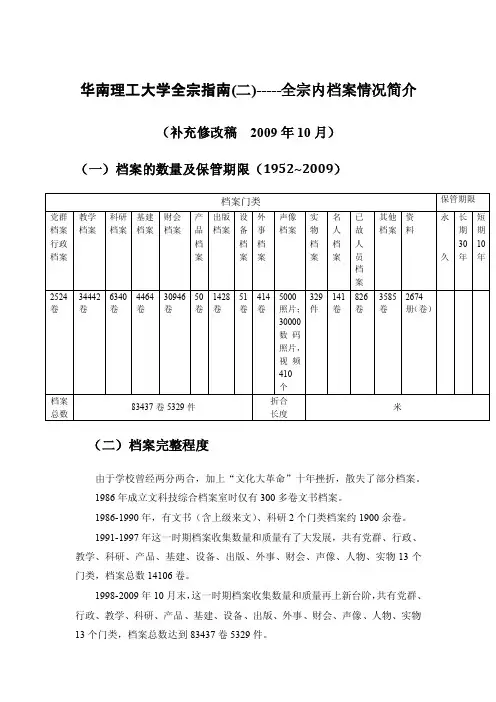
华南理工大学全宗指南(二)-----全宗内档案情况简介(补充修改稿2009年10月)(一)档案的数量及保管期限(1952~2009)(二)档案完整程度由于学校曾经两分两合,加上“文化大革命”十年挫折,散失了部分档案。
1986年成立文科技综合档案室时仅有300多卷文书档案。
1986-1990年,有文书(含上级来文)、科研2个门类档案约1900余卷。
1991-1997年这一时期档案收集数量和质量有了大发展,共有党群、行政、教学、科研、产品、基建、设备、出版、外事、财会、声像、人物、实物13个门类,档案总数14106卷。
1998-2009年10月末,这一时期档案收集数量和质量再上新台阶,共有党群、行政、教学、科研、产品、基建、设备、出版、外事、财会、声像、人物、实物13个门类,档案总数达到83437卷5329件。
(三)档案的利用价值及案例学校档案的利用率是衡量档案工作为学校中心工作服务、为校内各单位服务、为师生员工服务、以及为社会服务得如何的一个重要指标。
一直以来,学校档案馆在完成每年的立卷工作的同时,积极为学校各方面提供馆藏档案利用工作。
仅以2009年的数据为例,全年利用馆藏档案人次为2018人,查阅案卷5482卷次,复印档案资料11443张,拍摄或扫描档案资料469张。
自学校成立档案室,到1995年成立档案馆以来,主要从以下方面为校内外提供档案利用:1、为本校教学、科研和管理等各项目日常工作提供管理性规定材料。
2、为与外单位的土地争议,房屋维修、扩建、改建提供基建材料。
3、为校友出国、考研、找工、补办档案等等开具成绩单等档案证明。
4、为校庆展览、校史编写提供馆藏历史照片、实物及文字材料。
5、为各类评估、检查提供支撑材料6、为教师科研报奖、职务晋升提供凭证材料。
7、为治安保卫工作提供破案有关资料。
通过提供上述档案利用,不仅提升了馆藏档案的价值,还取得了很好的社会效益。
具体事例如下:1.1991年起我馆提供提供大量凭证,使学校在1997年4月18日领得校园土地红线图,结束了建校45年来我校没有红线图和土地权属证的历史,为学校土地、房产管理及开发与建设提供了合法依据。
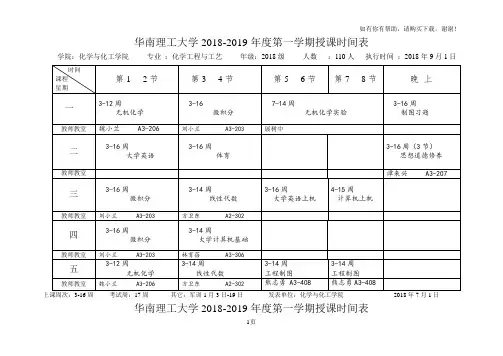
华南理工大学2018-2019年度第一学期授课时间表学院:化学与化工学院专业:化学工程与工艺年级:2018级人数:110人执行时间:2018年9月1日
上课周次:3-16周考试周:17周其它:军训1月3日-19日发表单位:化学与化工学院2018年7月1日
华南理工大学2018-2019年度第一学期授课时间表
1页
学院:化学与化工学院专业:制药工程年级:2018级人数:30人执行时间:2018年9月4日
上课周次:3-16周考试周:17周其它:军训1月3日-19日发表单位:化学与化工学院2018年7月1日
华南理工大学2018-2019年度第一学期授课时间表学院:化学与化工学院专业:能源化学工程年级:2018级人数:70人执行时间:2018年9月4日
2页
上课周次:3-16周考试周:17周其它:军训1月3日-19日发表单位:化学与化工学院2018年7月1日
华南理工大学2018-2019年度第一学期授课时间表学院:化学与化工学院专业:化学工程与工艺年级:2017级人数:102人执行时间:2018年9月4日
3页。
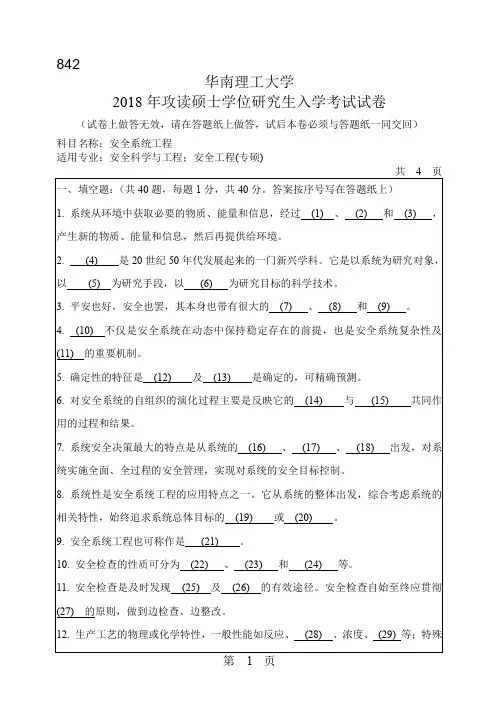
842华南理工大学2018年攻读硕士学位研究生入学考试试卷(试卷上做答无效,请在答题纸上做答,试后本卷必须与答题纸一同交回)科目名称:安全系统工程适用专业:安全科学与工程;安全工程(专硕)842华南理工大学2017年攻读硕士学位研究生入学考试试卷(试卷上做答无效,请在答题纸上做答,试后本卷必须与答题纸一同交回)科目名称:安全系统工程适用专业:安全科学与工程,安全工程(专硕)442华南理工大学2004年攻读硕士学位研究生入学考试试卷(试卷上做答无效,请在答题纸上做答,试后本卷必须与答题纸一同交回)科目名称:安全系统工程适用专业:安全技术及工程共页安全系统工程试题、、解释下面的基本概念(40分,每题4分)1.风险风险度2.可靠性可靠度3.故障4.系统5.顶上事件中间事件6.最小径集最小割集、、简答题(35分,每题7分)1.按定性方法和定量方法,分类列出系统安全分析方法?2.安全评价的原理是什么?3.事故树编制的方法是什么?4.简要说明典型决策的基本过程及要素?、、论述题(40分)1.谈谈你对安全系统工程的理解和认识。
(10分)2.论述重大事故后果分析方法对安全管理科学决策的重要性。
(15分)3.谈谈危险性预先分析方法及其对安全管理的作用。
(15)442华南理工大学2005年攻读硕士学位研究生入学考试试卷(试卷上做答无效,请在答题纸上做答,试后本卷必须与答题纸一同交回)科目名称:安全系统工程适用专业:安全技术及工程共 2 页一、解释下面的基本概念(40分,每题4分)安全危险事故故障可靠性危险源安全决策危险因素物质系数安全评价二、简答题(35分)1.如何编制安全检查表?(5分)2.最小割集在事故树分析中的作用?(7分)3.何谓安全标准?为什么不是以事故为零作为安全标准?(5分)4.现有一个刚充装好一氧化碳的钢瓶存放在某实验室,试用预先危险性分析对其进行危险性辨识。
(8分)5.画出故障率曲线示意图并解释其含义。
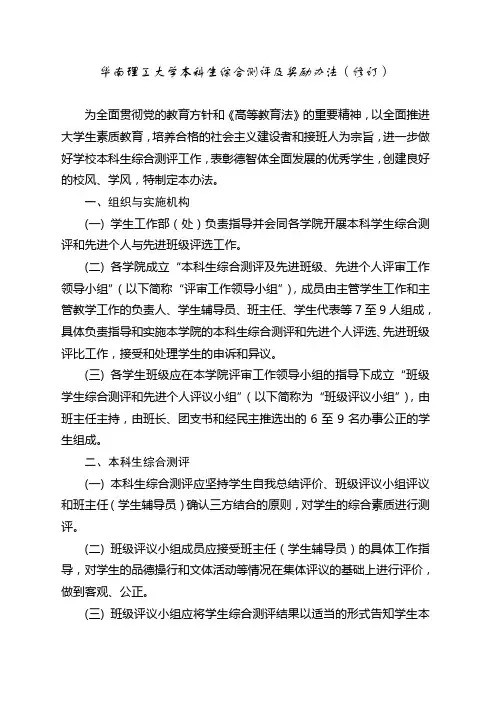
华南理工大学本科生综合测评及奖励办法(修订)为全面贯彻党的教育方针和《高等教育法》的重要精神,以全面推进大学生素质教育,培养合格的社会主义建设者和接班人为宗旨,进一步做好学校本科生综合测评工作,表彰德智体全面发展的优秀学生,创建良好的校风、学风,特制定本办法。
一、组织与实施机构(一) 学生工作部(处)负责指导并会同各学院开展本科学生综合测评和先进个人与先进班级评选工作。
(二) 各学院成立“本科生综合测评及先进班级、先进个人评审工作领导小组”(以下简称“评审工作领导小组”),成员由主管学生工作和主管教学工作的负责人、学生辅导员、班主任、学生代表等7至9人组成,具体负责指导和实施本学院的本科生综合测评和先进个人评选、先进班级评比工作,接受和处理学生的申诉和异议。
(三) 各学生班级应在本学院评审工作领导小组的指导下成立“班级学生综合测评和先进个人评议小组”(以下简称为“班级评议小组”),由班主任主持,由班长、团支书和经民主推选出的6至9名办事公正的学生组成。
二、本科生综合测评(一) 本科生综合测评应坚持学生自我总结评价、班级评议小组评议和班主任(学生辅导员)确认三方结合的原则,对学生的综合素质进行测评。
(二) 班级评议小组成员应接受班主任(学生辅导员)的具体工作指导,对学生的品德操行和文体活动等情况在集体评议的基础上进行评价,做到客观、公正。
(三) 班级评议小组应将学生综合测评结果以适当的形式告知学生本人。
学生本人可就异议之处向班主任或班级评议小组申请复核,对复核结果有异议可向所在学院评审工作领导小组说明情况。
(四) 本科生综合测评总积分由德育成绩积分、智育成绩积分和文体成绩积分三个方面组成。
具体测评内容和积分统计办法见附件1。
(五) 本科生综合测评采用学生信息管理系统实行网上操作。
三、奖励(一) 奖励金标准1.先进班级奖励金⑴先进班集体标兵:2000元;⑵先进班集体:1000元。
2. 先进个人奖励金⑴国家奖学金:8000元/人(如有变动,以教育部规定为准);⑵国家励志奖学金:5000元/人(如有变动,以教育部规定为准);⑶学校奖学金:一等:3000元/人,二等:2000元/人,三等:1000元/人;⑷捐赠奖学金:奖励金额根据学校与捐赠单位的协议确定。
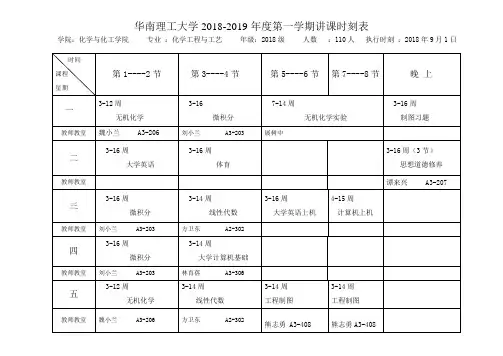
华南理工大学2018-2019年度第一学期讲课时刻表学院:化学与化工学院专业:化学工程与工艺年级:2018级人数:110人执行时刻:2018年9月1日上课周次:3-16周考试周:17周其它:军训1月3日-19日发表单位:化学与化工学院 2018年7月1日华南理工大学2018-2019年度第一学期讲课时刻表学院:化学与化工学院专业:制药工程年级:2018级人数:30人执行时刻:2018年9月4日上课周次:3-16周考试周:17周其它:军训1月3日-19日发表单位:化学与化工学院 2018年7月1日华南理工大学2018-2019年度第一学期讲课时刻表学院:化学与化工学院专业:能源化学工程年级:2018级人数:70人执行时刻:2018年9月4日上课周次:3-16周考试周:17周其它:军训1月3日-19日发表单位:化学与化工学院 2018年7月1日华南理工大学2018-2019年度第一学期讲课时刻表学院:化学与化工学院专业:化学工程与工艺年级:2017级人数:102人执行时刻:2018年9月4日注:有机化学实验时刻2-18周,上课地址:15号楼103、104、107、108有机测试室;303、304、308室有机合成室发表单位:化学与化工学院 2018年7月1日华南理工大学2018-2019年度第一学期讲课时刻表学院:化学与化工学院专业:制药工程年级:2017级人数:28人执行时刻:2018年9月4日注:有机化学实验时刻2-18周,上课地址:15号楼103、104、107、108有机测试室;303、304、308室有机合成室发表单位:化学与化工学院 2018年7月1日华南理工大学2018-2019年度第一学期讲课时刻表学院:化学与化工学院专业:能源化学工程年级:2017级人数:74人执行时刻:2017年9月4日注:有机化学实验时刻2-18周(2018/9-2019/1),上课地址:15号楼103、104、107、108有机测试室;303、304、308室有机合成室。
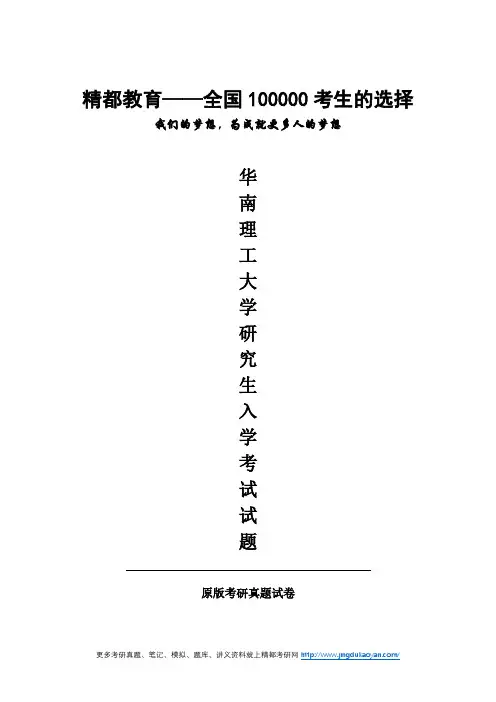
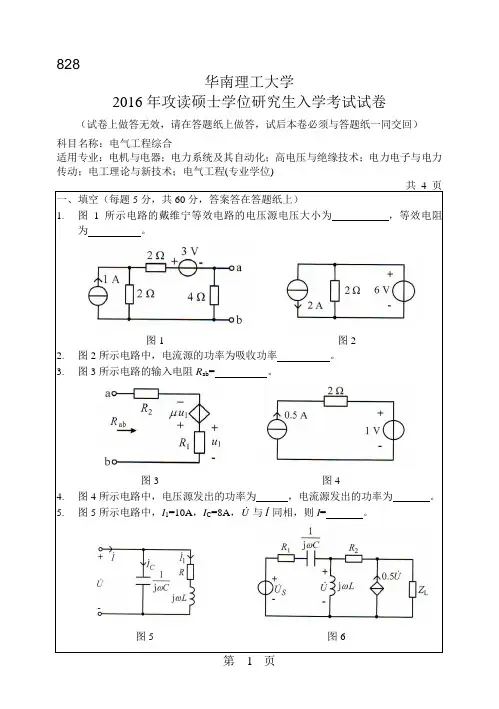
828华南理工大学2016年攻读硕士学位研究生入学考试试卷(试卷上做答无效,请在答题纸上做答,试后本卷必须与答题纸一同交回)科目名称:电气工程综合适用专业:电机与电器;电力系统及其自动化;高电压与绝缘技术;电力电子与电力传动;电工理论与新技术;电气工程(专业学位)图1 图2图2所示电路中,电流源的功率为吸收功率。
图3所示电路的输入电阻R ab=图3 图4所示电路中,电压源发出的功率为,电流源发出的功率为所示电路中,I1=10A,I C=8A U与I同相,则I= 。
图5 图6S 10U=∠-图7电力系统中负荷曲线指的是,日负荷曲线的用处是电力系统的简单不对称故障可分为横向故障和的故障边界条件类似,图8 图9电路如图9所示,试求电压比0/Su u图10 图1111所示电路中,S 10 V U =∠︒,求1I 和2I 。
12所示电路中,对称三相四线制电源电压为380/220 V ,三相电动机的每相等效阻抗3022.5 Z =+Ω,日光灯额定电压为220 V ,额定功率为40 W ,功率因数0.5。
分别求开关S 打开和闭合时的A I ,B I ,C I ,N I 及电源的输出功率。
设A 220U =∠图12 图13 图13所示电路中,S ()102cos50000 V u t t =,100 k R =Ω, 1 mH L =,调节电容C 使得电流表的读数为零,试求此时的L ()i t 。
一台星形连接,400 kW ,6300 V 的三相凸极同步发电机,额定运行时功率因数图14所示,已知各元件参数如下:100 MVA ,0.2d x ''=;发电机G2:N S =图15828华南理工大学2017年攻读硕士学位研究生入学考试试卷(试卷上做答无效,请在答题纸上做答,试后本卷必须与答题纸一同交回) 科目名称:电气工程综合适用专业:电机与电器;电力系统及其自动化;高电压与绝缘技术;电力电子与电力传动;电工理论与新技术;电气工程(专硕) 图1 图2所示电路中,电流源的功率为吸收功率 。
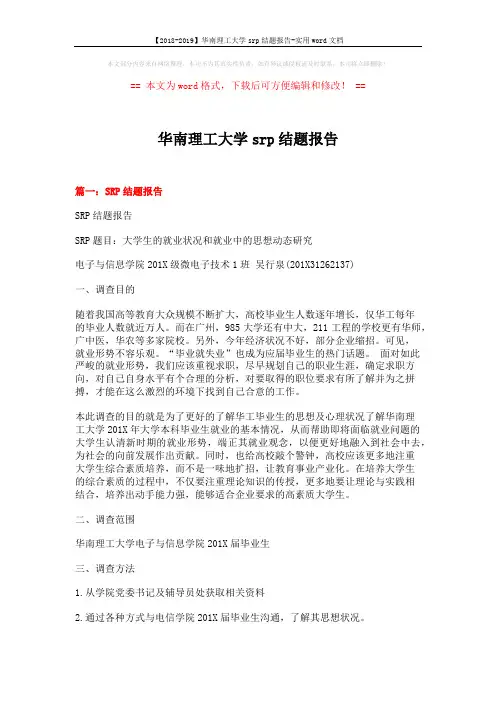
本文部分内容来自网络整理,本司不为其真实性负责,如有异议或侵权请及时联系,本司将立即删除!== 本文为word格式,下载后可方便编辑和修改! ==华南理工大学srp结题报告篇一:SRP结题报告SRP结题报告SRP题目:大学生的就业状况和就业中的思想动态研究电子与信息学院201X级微电子技术1班吴行泉(201X31262137)一、调查目的随着我国高等教育大众规模不断扩大,高校毕业生人数逐年增长,仅华工每年的毕业人数就近万人。
而在广州,985大学还有中大,211工程的学校更有华师,广中医,华农等多家院校。
另外,今年经济状况不好,部分企业缩招。
可见,就业形势不容乐观。
“毕业就失业”也成为应届毕业生的热门话题。
面对如此严峻的就业形势,我们应该重视求职,尽早规划自己的职业生涯,确定求职方向,对自己自身水平有个合理的分析,对要取得的职位要求有所了解并为之拼搏,才能在这么激烈的环境下找到自己合意的工作。
本此调查的目的就是为了更好的了解华工毕业生的思想及心理状况了解华南理工大学201X年大学本科毕业生就业的基本情况,从而帮助即将面临就业问题的大学生认清新时期的就业形势,端正其就业观念,以便更好地融入到社会中去,为社会的向前发展作出贡献。
同时,也给高校敲个警钟,高校应该更多地注重大学生综合素质培养,而不是一味地扩招,让教育事业产业化。
在培养大学生的综合素质的过程中,不仅要注重理论知识的传授,更多地要让理论与实践相结合,培养出动手能力强,能够适合企业要求的高素质大学生。
二、调查范围华南理工大学电子与信息学院201X届毕业生三、调查方法1.从学院党委书记及辅导员处获取相关资料2.通过各种方式与电信学院201X届毕业生沟通,了解其思想状况。
3.发放网络问卷供201X届毕业生填写。
四、调查结果与结论通过调查我们得到了往年的一些数据统计图表,而今年的具体数据还在统计中,据我们询问大部分同学们了解对比发现,基本上跟07级的同学也就是11届的情况相似,所以可以参考11届的数据。
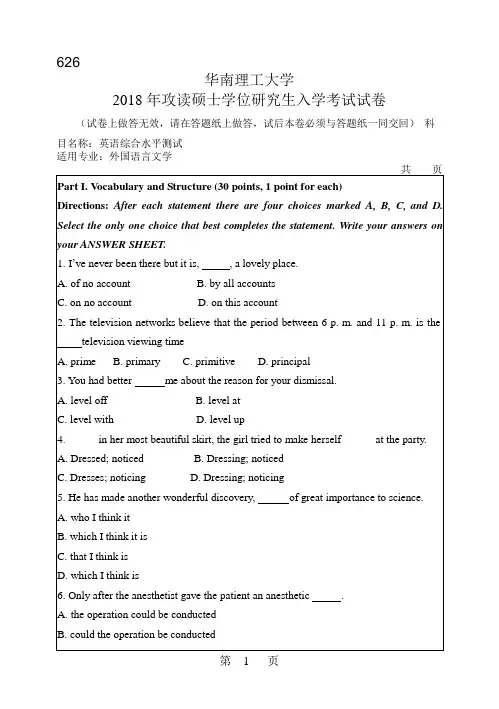
626华南理工大学2018 年攻读硕士学位研究生入学考试试卷(试卷上做答无效,请在答题纸上做答,试后本卷必须与答题纸一同交回)科目名称:英语综合水平测试适用专业:外国语言文学performances. Rather than playing tricks with alternatives presented to participants, we secretly altered the outcomes of their choices, and recorded how they react. For example, in an early study we showed our volunteers pairs of pictures of faces and asked them to choose the most attractive. In some trials, immediately after they made their choice, we asked people to explain the reasons behind their choices.Unknown to them, we sometimes used a double-card magic trick to secretly exchange one face for the other so they ended up with the face they did not choose. Common sense dictates that all of us would notice such a big change in the outcome of a choice. But the result showed that in 75 per cent of the trials our participants were blind to the mismatch, even offering “reasons” for their“choice”.We called this effect “choice blindness”, echoing change blindness,the phenomenon identified by psychologists where a remarkably large number of people fail to spot a major change in their environment. Recall the famous experiments where X asks Y for directions; while Y is struggling to help, X is switched for Z - and. Y fails to notice. Researchers are still pondering the full implications, but it does show how little information we use in daily life, and undermines the idea that we know what is going on around us.When we set out, we aimed to weigh in on the enduring, complicated debate about self-knowledge and intentionality. For all the intimate familiarity we feel we have with decision making, it is very difficult to know about it from the “inside”: one of the great barriers for scientific research is the nature of s ubjectivity.As anyone who has ever been in a verbal disagreement can prove, people tend to give elaborate justifications for their decisions, which we have every reason to believe are nothing more than rationalizations after the event. To prove such people wrong, though, or even provide enough evidence to change their mind, is an entirely different matter: who are you to say what my reasons are?But with choice blindness we drive a large wedge between intentions and actions in the mind. As our participants give us verbal explanations about choices they never made, we can show them beyond doubt - and prove it - that what they say cannot be true. So our experiments offer a unique window into confabulation (the story-telling we do to justify things after the fact) that is otherwise very difficult to come by. We can compare everyday explanations with those under lab conditions, looking for such things as the amount of detail in descriptions, how coherent the narrative is, the emotional tone, or even the timing or flow of the speech. Then we can create a theoretical framework to analyse any kind of exchange.This framework could provide a clinical use for choice blindness: for example, two of our ongoing studies examine how malingering might develop into truesymptoms, and how confabulation might play a role in obsessive-compulsive disorder.Importantly, the effects of choice blindness go beyond snap judgments. Depending on what our volunteers say in response to the mismatched outcomes of choices (whether they give short or long explanations, give numerical rating or labeling, and so on) we found this interaction could change their future preferences to the extent that they come to prefer the previously rejected alternative. This gives us a rare glimpse into the complicated dynamics of self-feedback (“I chose this, I publicly said so, therefore I must like it”), which we suspect lies behind the formation of many everyday preferences.We also want to explore the boundaries of choice blindness. Of course, it will be limited by choices we know to be of great importance in everyday life. Which bride or bridegroom would fail to notice if someone switched their partner at the altar through amazing sleight of hand? Yet there is ample territory between the absurd idea of spouse-swapping, and the results of our early face experiments.For example, in one recent study we invited supermarket customers to choose between two paired varieties of jam and tea. In order to switch each participant’s choice without them noticing, we created two sets of “magical” jars, with lids at both ends and a divider inside. The jars looked normal, but were designed to hold one variety of jam or tea at each end, and could easily be flipped over.Immediately after the participants chose, we asked them to taste their choice again and tell us verbally why they made that choice. Before they did, we turned over the sample containers, so the tasters were given the opposite of what they had intended in their selection. Strikingly, people detected no more than a third of all these trick trials. Even when we switched such remarkably different flavors as spicy cinnamon and apple for bitter grapefruit jam, the participants spotted less than half of all s witches.We have also documented this kind of effect when we simulate online shopping for consumer products such as laptops or cell phones, and even apartments. Our latest tests are exploring moral and political decisions, a domain where reflection and deliberation are supposed to play a central role, but which we believe is perfectly suited to investigating using choice blindness.Throughout our experiments, as well as registering whether our volunteers noticed that they had been presented with the alternative they did not choose, we also quizzed them about their beliefs about their decision processes. How did they think they would feel if they had been exposed to a study like ours? Did they think they would have noticed the switches? Consistently, between 80 and 90 per cent of people said that they believed they would have noticed something was wrong.Gervais, discovers a thing called “lying” and what it can get him. Within days, M ark is rich, famous, and courting the girl of his dreams. And because nobody knows what “lying” is? he goes on, happily living what has become a complete and utter farce.It’s meant to be funny, but it’s also a more serious commentary on us all. As Americans, we like to think we value the truth. Time and time again, public-opinion polls show that honesty is among the top five characteristics we want in a leader, friend, or lover; the world is full of sad stories about the tragic consequences of betrayal. At the same time, deception is all around us. We are lied to by government officials and public figures to a disturbing degree; many of our social relationships are based on little white lies we tell each other. We deceive our children, only to be deceived by them in return. And the average person, says psychologist Robert Feldman, the author of a new book on lying, tells at least three lies in the first 10 minutes of a conversation. “There’s always been a lot of lying,” says Feldman,whose new book, The Liar in Your Life, came out this month. “But I do think we’re seeing a kind of cultural shift where we’re lying more, it’s easier to lie, and in some ways it’s almost more acceptable.”As Paul Ekman, one of Feldman’s longtime lying colleagues and the inspiration behind the Fox IV series “Lie To Me” defines it,a liar is a person who “intends to mislead,”“deliberately,” without being asked to do so by the target of the lie. Which doesn’t mean that all lies are equally toxic: some are simply habitual –“My pleasure!”-- while others might be well-meaning white lies. But each, Feldman argues, is harmful, because of the standard it creates. And the more lies we tell, even if th ey’re little white lies, the more deceptive we and society become.We are a culture of liars, to put it bluntly, with deceit so deeply ingrained in our mind that we hardly even notice we’re engaging in it. Junk e-mail, deceptive advertising, the everyday p leasantries we don’t really mean –“It’s so great to meet you! I love that dress”– have, as Feldman puts it, become “a white noise we’ve learned to neglect.” And Feldman also argues that cheating is more common today than ever. The Josephson Institute, a nonprofit focused on youth ethics, concluded in a 2008 survey of nearly 30,000 high school students that “cheating in school continues to be rampant, and it’s getting worse.” In that survey, 64 percent of students said they’d cheated on a test during the past year, up from 60 percent in 2006. Another recent survey, by Junior Achievement, revealed that more than a third of teens believe lying, cheating, or plagiarizing can be necessary to succeed, while a brand-new study, commissioned by the publishers of Feldman’s book, shows that 18-to 34-year-olds--- those of us fully reared in this lying culture --- deceive more frequently than the general population.Teaching us to lie is not the purpose of Feldman’s book. His subtitle, in fact, is “the way to truthful relationships.” But if his book teaches us anything, it’s that we should sharpen our skills — and use them with abandon.Liars get what they want. They avoid punishment, and they win others’ affection. Liars make themselves sound smart and intelligent, they attain power over those of us who believe them, and they often use their lies to rise up in the professional world. Many liars have fun doing it. And many more take pride in getting away with it.As Feldman notes, there is an evolutionary basis for deception: in the wild, animals use deception to “play dead” when threatened. But in the modem world, the motives of our lying are more selfish. Research has linked socially successful people to those who are good liars. Students who succeed academically get picked for the best colleges, despite the fact that, as one recent Duke University study found, as many as 90 percent of high-schoolers admit to cheating. Even lying adolescents are more popular among their peers.And all it takes is a quick flip of the remote to see how our public figures fare when they get caught in a lie: Clinton keeps his wife and goes on to become a national hero. Fabricating author James Frey gets a million-dollar book deal. Eliot Spitzer’s wife stands by his side, while “Appalachian hiker” Mark Sanford still gets to keep his post. If everyone else is being rewarded for lying,don’t we need to lie, too, just to keep up?But what’s funny is that even as we admit to being liars, study after study shows that most of us believe we can tell when others are lying to us. And while lying may be easy, spotting a liar is far from it. A nervous sweat or shifty eyes can certainly mean a person’s uncomfortable, but it doesn’t necessarily mean they’re lying. Gaze aversion, meanwhile, has more to do with shyness than actual deception. Even polygraph machines are unreliable. And according to one study, by researcher Bella DePaulo, we’re only able to differentiate a lie from truth only 47 percent of the time, less than if we guessed randomly. “Basically everything we’ve heard about catching a liar is wrong,” says Feldman, who heads the College of Social and Behavioral Sciences at the University of Massachusetts, Amherst.Ekman, meanwhile, has spent decades studying micro-facial expressions of liars: the split-second eyebrow arch that shows surprise when a spouse asks who was on the phone; the furrowed nose that gives away a hint of disgust when a person says “I love you.” He’s trained everyone from the Secret Service to the TSA, and believes that with close study, it’s possible to identify those tiny emotions. The hard part, of course, is proving them. “A lot of times, it’s easier to believe,” says Feldman. “It takes a lot ofThere were, however, different explanations of this unhappy fact. Sean Pidgeon put the blame on “humanities departments who are responsible for the leftist politics that still turn people off.” Kedar Kulkarni blamed “the absence of a culture that privileges Learning to improve oneself as a human being.” Bethany blamed universities, which because they are obsessed with “maintaining funding” default on th e obligation to produce “well rounded citizens.” Matthew blamed no one,because i n his view the report’s priorities are just what they should be: “When a poet creates a vaccine or a tangible good that can be produced by a Fortune 500 company, I’ll rescind my comment.”Although none of these commentators uses the word, the issue they implicitly raise is justification. How does one justify funding the arts and humanities? It is clear which justifications are not available. You cannot argue that the arts and humanities are able to support themselves through grants and private donations. You cannot argue that a state’s economy will benefit by a new reading of “Hamlet.” You can’t argue -- well you can, but it won’t fly -- that a graduate who is well-versed in the history of Byzantine art will be attractive to employers (unless the employer is a museum). You can talk as Bethany does about “well rounded citizens,” but that ideal belongs to an earlier period, when the ability to refer knowledgeably to Shakespeare or Gibbon or the Thirty Years War had some cash value (the sociologists call it cultural capital). Nowadays, larding your conversations with small bits of erudition is more likely to irritate than to win friends and influence people.At one time justification of the arts and humanities was unnecessary because, as Anthony Kronman puts it in a new book, “Education’s End: Why Our Colleges and Universities Have Given Up on the Meaning of Life,” it was assumed that “a college was above all a place for the training of character, for the nurturing of those intellectual and moral habits that together from the basis for living the best life one can.”It followed that the realization of this goal required an immersion in the great texts of literature, philosophy and history even to the extent of memorizing them, for “to acquire a text by memory is to fix in one’s mind the image and example of the author and his subject.”It is to a version of this old ideal that Kronman would have us return, not because of a professional investment in the humanities (he is a professor of law and a former dean of the Yale Law School), but because he believes that only the humanities can address “the crisis of spirit we now confront” and “restore the wonder which those who have glimpsed the human condition have always felt, and which our scientific civilization, with its gadgets and discoveries, obscures.”As this last quotation makes clear, Kronman is not so much mounting a defense ofthe humanities as he is mounting an attack on everything else. Other spokespersons for the humanities argue for their utility by connecting them (in largely unconvincing ways) to the goals of science, technology and the building of careers. Kronman, however, identifies science, technology and careerism as impediments to living a life with meaning. The real enemies, he declares,are “the careerism that distracts from life as a whole” and “the blind acceptance of science and technology that disguise and deny our human condition.” These false idols,he says,block the way to understanding. We must turn to the humanities if we are to “meet the need for meaning in an age of vast but pointless powers,”for only the humanities can help us recover the urgency of “the question of what living is for.”The humanities do this, Kronman explains, by exposing students to “a range of texts that express with matchless power a number of competing answers to this question.” In the course of this program —Kronman calls it “secular humanism”—students will be moved “to consider which alternatives lie closest to their own evolving sense of self?” As they survey “the different ways of living that have been held up by different authors,” they will be encouraged “to enter as deeply as they can into the experiences, ideas, and values that give each its permanent appeal.” And not only would such a “revitalized humanism” contribute to the growth of the self,it “would put the conventional pieties of our moral and political world in question” and “bring what is hidden into the open — the highest goal of the humanities and the first responsibility of every teache r.”Here then is a justification of the humanities that is neither strained (reading poetry contributes to the state’s bottom line) nor crassly careerist. It is a stirring vision that promises the highest reward to those who respond to it. Entering into a conversation with the great authors of the western tradition holds out the prospect of experiencing “a kind of immortality” and achieving “a position immune to the corrupting powers of time.”Sounds great, but I have my doubts. Does it really work that way? Do the humanities ennoble? And for that matter, is it the business of the humanities, or of any other area of academic study, to save us?The answer in both cases, I think, is no. The premise of secular humanism (or of just old-fashioned humanism) is that the examples of action and thought portrayed in the enduring works of literature, philosophy and history can create in readers the desire to emulate them. Philip Sydney put it as well as anyone ever has when he asks (in “The Defense of Poesy” 1595), “Who reads Aeneas carrying old Anchises on his back that wishes not it was his fortune to perform such an excellent act?” Thrill to this picture of42.What does Anthony Kronman oppose in the process to strive for meaningful life?A.Secular humanism.B. Careerism.C. Revitalized humanismD. Cultural capital.43.Which of the following is NOT mentioned in this article?A.Sidney Carton killed himself.B.A new reading of Hamlet may not benefit economy.C.Faust was not willing to sell his soul.D.Philip Sydney wrote The Defense of Poesy.44.Which is NOT true about the author?A.At the time of writing, he has been in the field of the humanities for 45 years.B.He thinks the humanities are supposed to save at least those who study them.C.He thinks teachers and students of the humanities just learn how to analyze literary effects and to distinguish between different accounts of the foundations of knowledge.D.He thin ks Kronman’s remarks compromise the object its supposed praise.45.Which statement could best summarize this article?A.The arts and humanities fail to produce well-rounded citizens.B.The humanities won’t save us because humanities departments are too leftist.C.The humanities are expected to train character and nurture those intellectual andmoral habits for living a life with meaning.D.The humanities don’t bring about effects in the world but just give pleasure to those who enjoy them.Passage fourJust over a decade into the 21st century, women’s progress can be celebrated across a range of fields. They hold the highest political offices from Thailand to Brazil, Costa Rica to Australia. A woman holds the top spot at the International Monetary Fund; another won the Nobel Prize in economics. Self-made billionaires in Beijing, tech innovators in Silicon Valley, pioneering justices in Ghana—in these and countless other areas, women are leaving their mark.But hold the applause. In Saudi Arabia, women aren’t allowed to drive. In Pakistan, 1,000 women die in honor killings every year. In the developed world, women lag behind men in pay and political power. The poverty rate among women in the U.S. rose to 14.5% last year.To measure the state of women’s progress. Newsweek ranked 165countries, looking at five areas that affect women’s lives; treatment under the law, workforce participation, political power, and access to education and health care. Analyzing datafrom the United Nations and the World Economic Forum, among others, and consulting with experts and academics, we measured 28 factors to come up with our rankings.Countries with the highest scores tend to be clustered in the West, where gender discrimination is against the law, and equal rights are constitutionally enshrined. But there were some surprises. Some otherwise high-ranking countries had relatively low scores for political representation. Canada ranked third overall but 26th in power, behind countries such as Cuba and Burundi. Does this suggest that a woman in a nation’s top office translates to better lives for women in general? Not exactly.“Trying to quantify or measure the impact of women in politics is hard because in very few countries have there been enough women in politics to make a difference,” says Anne-Marie Goetz, peace and security adviser for U.N. Women.Of course, no index can account for everything. Declaring that one country is better than another in the way that it treats more than half its citizens means relying on broad strokes and generalities. Some things simply can’t be measured.And cross-cultural comparisons can t account for difference of opinion.Certain conclusions are nonetheless clear. For one thing, our index backs up a simple but profound statement made by Hillary Clinton at the recent Asia-Pacific Economic Cooperation summit. “When we liberate the economic potential of women, we elevate the economic performance of communities, nations, and the world,”she said. “There’s a simulative effect that kicks in when women have greater access to jobs and the economic lives of our countries: Greater political stability. Fewer military conflicts. More food. More educational opportunity for children. By harnessing the economic potential of all women, we boost opportunity for all people.”46.What does the author think about women’s progress so far?A.It still leaves much to be desired.B.It is too remarkable to be measured.C.It has greatly changed women's fate.D.It is achieved through hard struggle.47.In what countries have women made the greatest progress?A.Where women hold key posts in government.B.Where women’s rights are protected by law.C.Where women’s participation in management is high.D.Where women enjoy better education and health care.48.What do Newsweek rankings reveal about women in Canada?A.They care little about political participation.B.They are generally treated as equals by men.C.They have a surprisingly low social status.D.They are underrepresented in politics.49.What does Anne-Marie Goetz think of a woman being in a nation's top office?A.It does not necessarily raise women's political awareness.B.It does not guarantee a better life for the nation's women.C.It enhances women's status.D.It boosts women's confidence.50.What does Hillary Clinton suggest we do to make the world a better place?A.Give women more political power.B.Stimulate women's creativity.C.Allow women access to education.D.Tap women's economic potential.Passage fiveThe idea that government should regulate intellectual property through copyrights and patents is relatively recent in human history, and the precise details of what intellectual property is protected for how long vary across nations and occasionally change. There are two standard sociological justifications for patents or copyrights: They reward creators for their labor, and they encourage greater creativity. Both of these are empirical claims that can be tested scientifically and could be false in some realms.Consider music. Star performers existed before the 20th century, such as Franz Liszt and Niccolo Paganini, but mass media produced a celebrity system promoting a few stars whose music was not necessarily the best or most diverse. Copyright provides protection for distribution companies and for a few celebrities, thereby helping to support the industry as currently defined, but it may actually harm the majority of performers. This is comparable to Anatole France's famous irony, "The law, in its majestic equality, forbids the rich as well as the poor to sleep under bridges." In theory, copyright covers the creations of celebrities and obscurities equally, but only major distribution companies have the resources to defend their property rights in court. In a sense, this is quite fair, because nobody wants to steal unpopular music, but by supporting the property rights of celebrities, copyright strengthens them as a class in contrast to anonymous musicians.Internet music file sharing has become a significant factor in the social lives of children, who download bootleg music tracks for their own use and to give as gifts to friends. If we are to believe one recent poll done by a marketing firm rather than social。
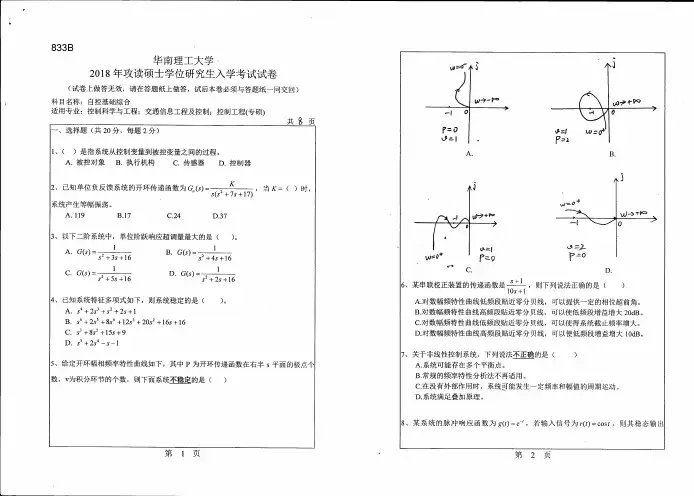
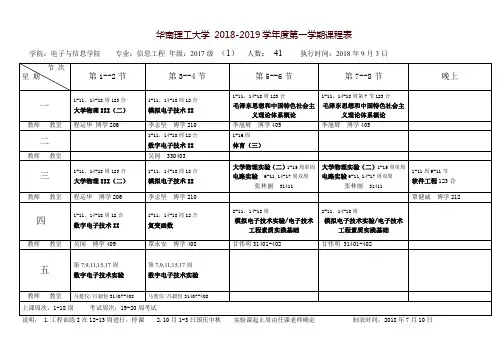
华南理工大学2018-2019学年度第一学期课程表学院:电子与信息学院专业:信息工程年级:2017级(1)人数:41执行时间:2018年9月3日说明: 1.工程训练I在12-13周进行,停课 2.10月1-3日国庆中秋实验课起止周由任课老师确定制表时间:2018年7月10日学院:电子与信息学院专业:信息工程年级:2017级(2)人数:40执行时间:2018年9月3日说明: 1.工程训练I在12-13周进行,停课 2.10月1-3日国庆中秋实验课起止周由任课老师确定制表时间:2018年7月10日学院:电子与信息学院专业:信息工程年级:2017级(3)人数:40执行时间:2018年9月3日说明: 1.工程训练I在12-13周进行,停课 2.10月1-3日国庆中秋实验课起止周由任课老师确定制表时间:2018年7月10日学院:电子与信息学院专业:信息工程年级:2017级(4)人数:41执行时间:2018年9月3日说明:1.工程训练I在12-13周进行,停课 2.10月1-3日国庆中秋实验课起止周由任课老师确定制表时间:2018年7月10日学院:电子与信息学院专业:信息工程年级:2017级(5)人数:40执行时间:2018年9月3日说明:1.工程训练I在12-13周进行,停课 2.10月1-3日国庆中秋实验课起止周由任课老师确定制表时间:2018年7月10日学院:电子与信息学院专业:信息工程年级:2017级(6)人数:30执行时间:2018年9月3日学院:电子与信息学院专业:信息工程年级:2017级(冯班)人数:45执行时间:2018年9月3日说明:1.工程训练I在12-13周进行,停课 2.10月1-3日国庆中秋实验课起止周由任课老师确定制表时间:2018年7月10日华南理工大学2018-2019学年度第一学期课程表学院:电子与信息学院专业:电子科学与技术年级:2017级(卓越)人数:35执行时间:2018年9月3日说明:1.工程训练I在12-13周进行,停课 2.10月1-3日国庆中秋实验课起止周由任课老师确定制表时间:2018年7月10日华南理工大学2018-2019学年度第一学期课程表学院:电子与信息学院专业:电子科学与技术年级:2017级(电科1)人数:39执行时间:2018年9月3日说明:1.工程训练I在12-13周进行,停课 2.10月1-3日国庆中秋实验课起止周由任课老师确定制表时间:2018年7月10日华南理工大学2018-2019学年度第一学期课程表学院:电子与信息学院专业:电子科学与技术年级:2017级(电科2)人数:40执行时间:2018年9月3日说明:1.工程训练I在12-13周进行,停课 2.10月1-3日国庆中秋实验课起止周由任课老师确定制表时间:2018年7月10日。
附录:华南理工大学电子与信息学院研究生综合测评积分统计办法一、综合测评总积分综合测评的总积分(S )由学习成绩积分(C )、学术科研分(K )、品德及社会公益分(D )三个方面组成。
综合测评总积分S 按以下公式计算: S= 0.8C + K + D二、学习成绩积分C学习成绩积分C 为参评学年内所学课程成绩的折算积分。
计算公式为:()()∑∑∑∑⨯⨯非学位课学分学位课学分+非学位课学分非学位课成绩+学位课学分学位课成绩=8.08.0C说明:1、学位课程中科学社会主义的理论与实践、自然辨证法概论和基础英语三门课程按原始分计算2、其它学位课程和非学位课程的成绩按标准分计算,计算方法为该课程的平均分与85分拉平后的比例进行折算,计算公式为:标准分=原始分该课程的平均分⨯853、非学位课程只计算本学院开设的课程4、 二年级研究生不再计算成绩分C 。
三、学术科研分K学术科研分K 计算公式如下:K= K1+K2 其中:K1——科研表现分K2——学术成果分 1、 科研表现分K1科研表现分K1的计算方法参见附件一 2、 学术成果分K2学术成果分K2的计算方法参加附件二和附件三。
3、 以上各项没有列举而确需要加分的,由学院评审组与有关班级的测评负责人共同商定。
各班评议小组对加分项目不明的,由学院评审组裁定。
四、品德及社会公益分D品德及社会公益分D计算公式如下:D=D1+D2-D3其中:D1——品德综合评定分D2——社会活动及表现加分D3——扣分部分1、品德综合评定分D1品德综合评定分D1满分为10分。
针对学生的思想道德、身心健康、学习态度、组织纪律性、集体责任心、文明礼貌、社会公德等方面给予综合评价。
此项评定由班主任、班级评议小组和学生工作办公室给予评分,班主任负责20%的分数评定,班级评议小组负责30%的分数评定,学工办负责50%的分数评定,D1为三方面评分之和。
2、社会活动及表现加分D2社会活动及表现加分D2满分10分,是在集体活动方面给学生的奖励,超过10分按10分计。